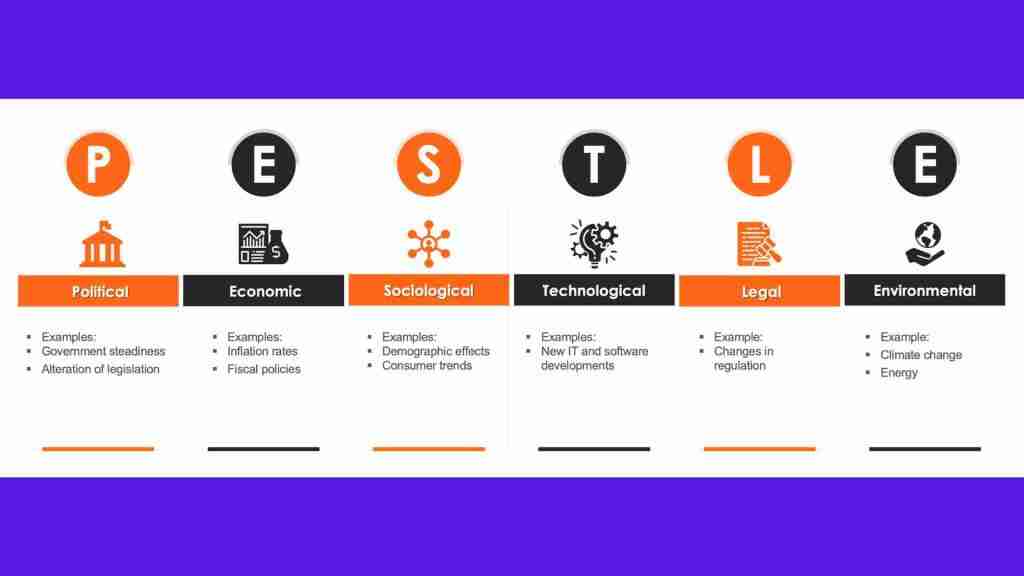In the ever-evolving world of business, the ability to assess and respond to constant changes is crucial. One timeless tool that has been guiding businesses for nearly six decades is PESTLE.
Understanding PESTLE
PESTLE is an acronym that stands for Political, Economic, Social, Technological, Legal, and Environmental. It’s a tool used in strategic management and marketing to analyze and monitor the macro-environmental (external marketing environment) factors that can impact an organization. The aim is to identify potential opportunities and threats associated with the wider environment in which the organization operates.

Origins of PESTLE
The origins of the PESTLE analysis are as follows:
PEST Analysis
Originally, the model was called PEST, which comprised of the Political, Economic, Social, and Technological factors. Over time, to cover a more comprehensive external analysis, the model was extended to include Legal and Environmental factors, making it PESTLE.
Extensions
The model was expanded to become more inclusive, covering a broader range of external factors. For example, some versions include Ethical factors (PESTLEE) or Demographic factors (STEEPLED).
Origins
The concept of examining external forces that could impact an organization has its roots in the SWOT analysis, which looks at Strengths, Weaknesses, Opportunities, and Threats. PESTLE can be seen as an extension of the “Opportunities” and “Threats” sections of SWOT, specifically focusing on macro-environmental factors.
Usage Over Time
The PESTLE analysis has been widely used in business and strategic management over the past few decades. Its origin is difficult to pinpoint to a specific date or individual, but it has been a staple in strategic planning and business courses since the mid-20th century.
PESTLE evolved over time as business thinkers recognized the need to consider a broad array of external factors that could impact an organization. The tool helps businesses to be proactive rather than reactive to changes in their macro-environment.
The Power and Limitations of PESTLE
While PESTLE acts as a checklist, prompting businesses to think about changes in each of these domains, it’s crucial not to use it superficially. A common pitfall is that businesses list out the factors without delving into their implications. For instance, noting political changes without considering how they will influence the business landscape is a missed opportunity.
Three major issues businesses often encounter while employing PESTLE are:
- Short-sightedness: Companies may only focus on the present and not consider potential future outcomes.
- Lack of Data-Driven Decisions: Instead of leveraging concrete data, some rely solely on anecdotal information or headlines.
- Neglecting the “So What?” Factor: Businesses sometimes fail to determine how specific changes will affect them and their customer base.
Making the Most of PESTLE
For PESTLE to be a valuable tool, it requires proactive engagement. With the rapid pace of change today, businesses should subconsciously engage with PESTLE factors regularly, with assessments ranging from quarterly to annually, based on your industry.
Several resources can help you with this. From global consumer research organizations like Mintel to consultancies like McKinsey, the wealth of free information is immense. These insights are readily available in digestible formats, enabling your business to keep its finger on the pulse of macro-environmental shifts.
However, even with the availability of such data, businesses sometimes overlook their significance due to skill gaps. It’s essential to understand the art of synthesis, application, and looking beyond the immediate horizon. In industries where buying habits or other dynamics shift rapidly, staying updated is non-negotiable.
Use PESTLE in Financial Planning
When laying out strategies and foreseeing future developments, PESTLE assists in anticipating how events might influence a company’s trajectory. It’s imperative to incorporate this into financial planning. It’s quite revealing how many businesses bypass regular planning. Studies indicate that businesses encountering financial turmoil often have these things in common : a lack of planning, marketing, and financial structure. Such deficiencies often determine a business’ fate.
Avoid Complacency
A key pitfall is complacency, especially when a company feels it has mastered its market. The belief that they’ve “got it nailed” blinds them to looming changes or threats. When PESTLE analysis first came out, many believed it suited only large organizations. However, its relevance isn’t confined to scale. Whether you’re an employee contemplating your next move, a student deciding a career path, a small or global business, understanding the world’s trajectory and determining your role within it is vital.

Horizon Scanning
A forward-looking approach “horizon scanning,” extends your perspective beyond the immediate to anticipate future developments. You can’t create an effective business plan in a vacuum. For optimal success, it’s super important to factor in global events and their potential impact on your business.
The Ripple Effect
Ignoring the global context when crafting your business plan is like working in a bubble. Merely inputting figures into a spreadsheet without considering external factors lacks foundation and depth. Those who believe they’re insulated from global political shifts or believe their small community is unaffected by global happenings are mistaken. The interconnectedness of the world means distant events can ripple back, influencing even the most remote areas. Events such as climate change or global pandemics have underscored this.
Use PESTLE Well
PESTLE’s structure can sometimes be its downfall. There’s a tendency to confine topics strictly under their designated categories, potentially missing broader interpretations. For instance, the “S” in PESTLE, standing for “social,” can also encompass customers and various stakeholders. Each component of the PESTLE model, from economic to legal factors, requires expansive thinking, rather than a quick list.
There’s flexibility within the PESTLE framework. It isn’t about rigidly fitting every piece of information under a pre-defined header. Instead, it’s about understanding external factors, visualizing future scenarios, and categorizing insights that are relevant to your business.
Visualize your PESTLE
Creative individuals might find value in crafting a visual representation of their PESTLE analysis, such as a collage. This method encourages a deeper, more intuitive understanding of global trends and their potential impacts. However, it’s crucial to supplement such intuitive methods with data-driven research to challenge and refine your insights.
Remember, the mind can be cluttered; getting your thoughts on paper can pave the way for innovation and progress.
Next Steps
PESTLE isn’t just a business tool; it’s a lens through which you can see the world and your business’ place in it. Recognizing external changes and understanding their potential impact is a step toward proactive planning, helping you towards your next big win.
If you’ve found this article useful, take a look at our in-depth guide to blue ocean strategy here. The two models work really well when you use them in combination.
